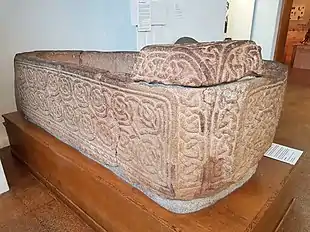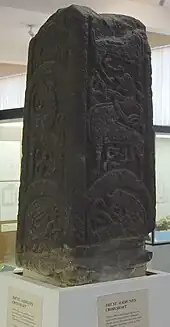Alkmund of Derby
Alkmund of Derby (or of Lilleshall), also spelt Ealhmund, Alhmund, Alcmund, or Alchmund (d. c. 800) was a son of Alhred of Northumbria, who was caught up in the kingdom's dynastic struggles.
Saint Alkmund | |
|---|---|
| Born | circa 770 AD |
| Died | 800 AD |
| Feast | 19 March |

History
After more than twenty years in exile among the Picts, Alkmund returned with an army. As king, he acquired a reputation for being charitable to the poor and orphaned. He was killed about 800, for which King Eardwulf of Northumbria was held responsible. Whatever the exact circumstances, his death was regarded as a martyrdom, and Alkmund as a saint.
He was buried first in Shropshire,[1] and then removed to "Northworthy", i.e. modern Derby, because of Viking raids.[2][3]

Miracles were reported at the tomb. In the early tenth century, his remains were translated to Shrewsbury, probably by Æthelflæd, Lady of the Mercians.[5]
When St Alkmund's, Shrewsbury became the property of Lilleshall Abbey about 1145, his body was translated back to Derby.[6]
When St Alkmund's Church, Derby was demolished in 1968, traces of several earlier churches were revealed, stretching back to the 9th century. Artefacts found included the stone sarcophagus now in Derby Museum and Art Gallery.[7]
Six churches in England are dedicated to him, at Derby (replaced by St Alkmund's (new) Church, Derby), Duffield (Derbyshire), Shrewsbury, Whitchurch (Shropshire), Aymestrey (Herefordshire) and Blyborough (Lincolnshire).[6]
His feast day is 19 March.
Gallery
 St Alkmund's Church, Derby, from Queen Street, 1882
St Alkmund's Church, Derby, from Queen Street, 1882 Sarcophagus of St Alkmund, Derby Museum
Sarcophagus of St Alkmund, Derby Museum
See also
References
- "St Alkmund: Patron Saint of Derby", BBC - Faith, September 4, 2014
- "Ealhmund of Derby, son of Alhred", Saints in Scottish Place-Names
- Signage at Derby Museum notes that he was recorded in the 9th century as being a saint buried in the Minster beside the Derwent at a place called Northworthy – whose Viking name is Derby.
- The museum's exhibit label says "Part of 9th-century Anglo Saxon stone cross which once stood at St. Alkmund's church, Derby. This stone was found when St Alkmund's church was rebuilt in 1844. The cross was originally about 4 metres tall. There are birds and beasts carved on all four sides."
- Meijns, Brigitte (2010). "The Policy on Relic Translations of Baldwin II of Flanders (879–918), Edward of Wessex (899–924), and Æthelflæd of Mercia (d.924): A Key to Anglo-Flemish Relations". In Rollason, David; Leyser, Conrad; Williams, Hannah (eds.). England and the Continent in the Tenth Century. Turnhout, Belgium: Brepols. p. 476. ISBN 9782503532080.
- Saint Alkmund, His Life, Murder and Cults, Derek & Marion Taulbut, 1998
- Sarah Allard, Nicola Rippon (2003). Goodey's Derby (Paintings and Drawing in the Collection of Derby Museum & Art Gallery) p.134. Breedon Books Publishing Co Ltd. ISBN 978-1-85983-379-7.
External links
- Rollason, David (2004). "Ealhmund [St Ealhmund] (d. 800)". Oxford Dictionary of National Biography. Oxford University Press. doi:10.1093/ref:odnb/49420. ISBN 978-0-19-861412-8. (subscription or UK public library membership required)
- Ealhmund 25 at Prosopography of Anglo-Saxon England